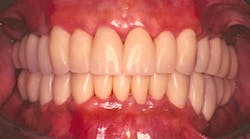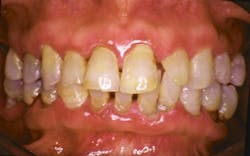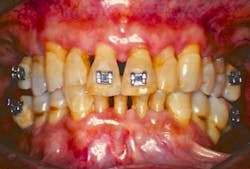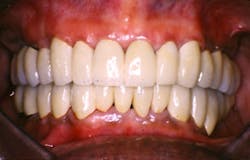Temporaries versus provisionals: An important distinction
Dr. Michael W. Herndon says the terms temporaries (or temporary crowns/bridges) and provisionals are often interchanged and thus used incorrectly. In this article, he explains why the distinctions between the two types of interim dental restorations are so important by detailing the characteristics and goals of each.
The terms temporaries (or temporary crowns/bridges) and provisionals are often interchanged and thus used incorrectly. It is exceedingly important to be aware of the distinction between these two types of interim dental restorations. I have prepared a list of the important characteristics that separate these into distinct categories. While these lists are not meant to be an exhaustive evaluation of this subject, they may be taken as the basic differences of which to be aware. Also, please note that in some circles of thought, the term prototype has been exchanged for the term provisional.
Temporaries
Temporaries are intended to do several important things:
1. Hold space vertically and horizontally for an incoming restoration.
2. Cover exposed dentin and thus prevent bacterial encroachment onto the tooth surfaces and into the exposed tubules.
3. Minimize or prevent sensitivity during the time between preparation and the final restoration.
Hopefully this will be done meticulously so the temporary does not negatively affect the gingiva surrounding the tooth or teeth. Regardless, these are the primary goals of temporaries.
Recall how common it used to be (and still is in some outdated practices) to place the kind of temporaries that soft tissue hates: the prefabricated aluminum temporaries seated by filling with cement and having the patient bite down, jamming the margins into the gums like a knife! Alas, these types of temporaries do, in effect, fulfill the primary goal of a temporary as outlined above.
Make no mistake: Margins should be placed and a temporary should be designed to be kind to the surrounding tissue, yet the fundamentals of a temporary are simply those outlined above.
Provisionals
Provisionals, on the other hand, are an entirely different type of restoration, albeit provisional. The goals of provisionals are:
1. All of the above goals regarding temporaries.
2. Manage tissue so that it remains healthy, with little or no inflammation during the provisional phase. The reason I say "little inflammation" is that the nature of acrylic near tissue can result in inflammation secondary to bacterial growth, tissue reaction to acrylic, and tissue rebound during healing that may come in contact with the provisional material.
The ultimate goal would be no inflammation anywhere, but that perfection is not always met even with the best of intentions. Any inflammation present during the provisional phase should always reverse itself after the seating of the final case, provided the principles of periodontics and restorative dentistry are followed.
3. Verify comfort in occlusion for the patient. Regarding the subject of occlusion, finding a patient-generated mandibular position is advisable for trouble-free occlusion, especially if the occlusal position is to be altered during treatment of the case. This should ideally result in a negative occlusal sense for the patient, meaning the patient should not be aware of the occlusion.
Most adult patients initially present with a mandibular position that is driven by pathology. A patient-generated mandibular position automatically takes into account these pathological changes in both soft and hard tissues that have occurred throughout the patient’s life.
4. Verify esthetic parameters that satisfy the patient's expected goals (not including final shades and stains in the final porcelain). Shape, midlines, smile line, embrasure shapes, position of contacts within reason all can be verified during the provisional phase.
5. Verify phonetic evaluation for speech and airflow (sibilance, no whistlers, articulation, lisp).
6. Ensure cleansability. Obviously, this is very important for bacterial control, but also for training the patient as necessary for future final restorations.
7. Provide durability. Provisionals should be made to last over time with relines if necessary. Sometimes provisionals are placed before surgery and altered along the way after completion of all surgical manipulation, depending on the requirements of the case.
8. Most importantly:The provisional is designed to be a template for the final restoration. Considering this, when a case is finally seated, the doctor and patient know exactly how well it is going to work since it has, essentially, already been tried out by the patient during the provisional phase. Without this essential step, it can be no more than a guess—albeit an educated and calculated guess—but still a guess.
For example: If a patient presents for reconstructive dentistry—especially a procedure that requires changes in vertical dimension—how is it possible to mount a case to an open bite of untried distance, create a final reconstruction, and ensure that the resulting final case will be tolerated by the patient? But if that vertical dimension, mandibular position, and occlusal scheme are already worked out in a provisional, and the patient is comfortable over a period of time with a negative occlusal sense, then one can proceed with certainty that the final restoration will be well-tolerated.
The concepts of provisionals are not limited to full reconstructions. These same principles can be applied wherever necessary, whether on teeth or implants, multiple units or single units. Indeed, while constructing an implant-supported restoration in the esthetic zone, it is often necessary to employ these principles to contour tissue and ensure the required parameters of success are met.
As stated at the outset, this is not meant to be an exhaustive list of characteristics and parameters regarding provisionals; rather, it is intended to point out the tremendous differences between temporary and provisional restorations. As you can see, the distinct and important differences between temporaries and provisionals cannot be overstated. It is a misnomer to label a restoration that only meets the criteria of a temporary as a provisional. Unfortunately, this happens more often than one would expect.
Provisionals versus temporaries: An important distinction indeed.





